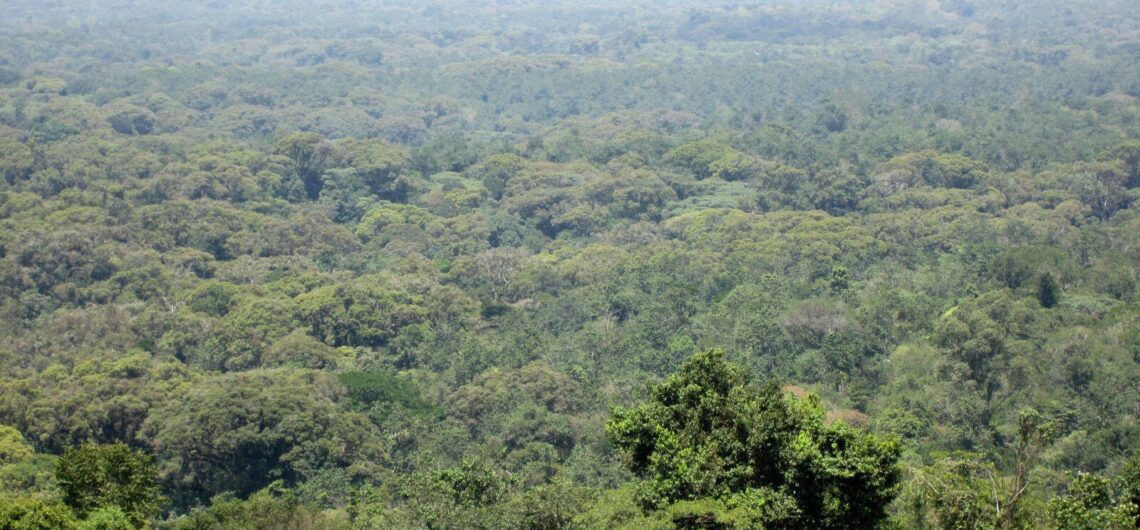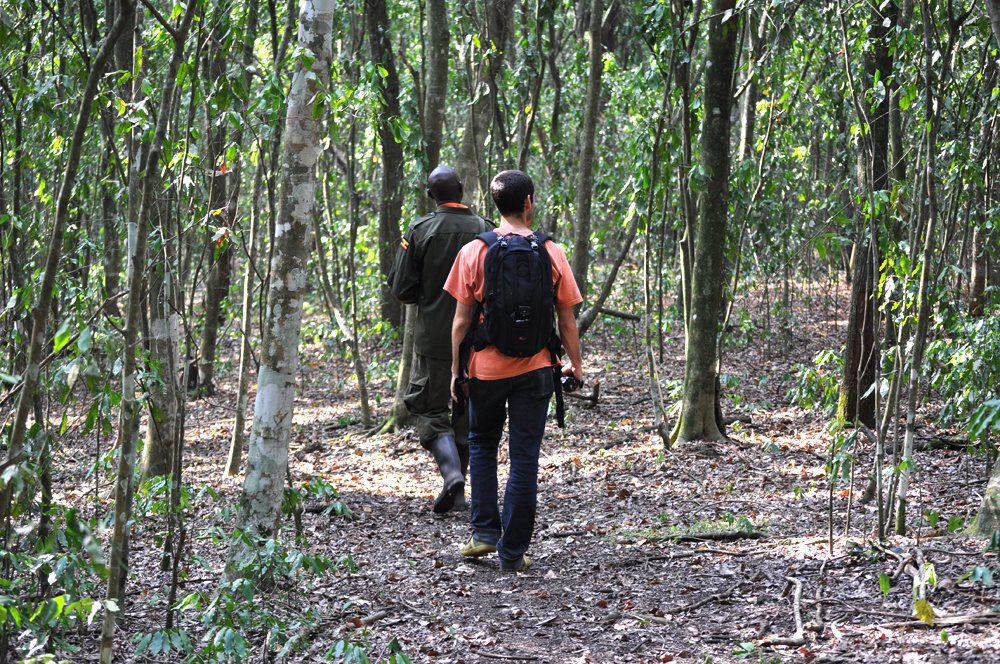Exploring Maramagambo Forest
Maramagambo Forest is one of the largest and most fascinating tropical forests in Uganda, located in the southwestern part of the country. It lies in the southern part of Queen Elizabeth National Park, stretching towards the border of the Democratic Republic of Congo. Known for its biodiversity, stunning scenery, and rich ecological importance, Maramagambo Forest offers visitors a unique experience of Uganda’s natural heritage.
Location and Geography
Maramagambo Forest is situated in Bushenyi and Rubirizi districts, covering an area of approximately 298 square kilometers. The forest is part of the Albertine Rift, a biodiverse region that includes various other protected areas and forests. It is positioned between the Kichwamba escarpment and the crater lakes of the Queen Elizabeth National Park, making it accessible to visitors exploring this renowned wildlife area.
The forest’s name, “Maramagambo,” is derived from a local legend. It is said that a group of young people once got lost in the forest for several days and, upon finding their way out, were too exhausted to speak—hence, the name, which loosely translates to “end of words” in the local language.
Biodiversity and Wildlife
Maramagambo Forest is rich in biodiversity, home to a wide variety of flora and fauna. The ecosystem comprises thick tropical rainforests, swamps, and savannah woodlands, creating a diverse habitat for different species. The forest’s unique environment supports many mammals, birds, reptiles, and insects, making it a significant area for conservation.
Primates
One of the highlights of Maramagambo Forest is its population of primates. Visitors can spot several species, including:
- Chimpanzees: Although not as numerous as in Kibale National Park, Maramagambo Forest hosts a population of chimpanzees that are sometimes seen during nature walks.
- Red-tailed monkeys
- Black-and-white colobus monkeys
- Vervet monkeys
- L’Hoest’s monkeys
These primates play an essential role in the ecosystem by helping to disperse seeds and maintain the health of the forest.
Mammals
Apart from primates, the forest is also home to other mammals such as:
- Forest elephants: Though rare to see, elephants occasionally pass through the forest as they migrate between different parts of the national park.
- Bushbucks
- Civets
- Leopards: Though elusive, these big cats are known to inhabit the dense areas of the forest.
- Bats: Maramagambo Forest is famous for its bat cave, which is a significant attraction for visitors.
Birds
Maramagambo Forest is a paradise for bird watchers, with over 200 bird species recorded in the area. The forest is part of the Important Bird Area (IBA) network in Uganda, recognized for its role in bird conservation. Some notable species include:
- African Emerald Cuckoo
- White-naped Pigeon
- Rufous-bellied Heron
- Yellow-billed Barbet
- Forest Flycatcher
The presence of both forest and savannah bird species adds to the diversity of avian life in Maramagambo, making it a sought-after destination for bird enthusiasts.
The Bat Cave and Python
One of the most intriguing features of Maramagambo Forest is the bat cave, located near the Blue Lake. The cave is home to thousands of bats, mainly fruit bats, which create an eerie atmosphere with their constant fluttering and squeaking. However, the cave is not only a habitat for bats but also a hunting ground for pythons that prey on these flying mammals.
Visitors can view the cave from a safe distance on a guided walk, with some sections having a glass viewing platform to observe the bats and the occasional appearance of a python. The bat cave became even more notable after an outbreak of the Marburg virus in the 2000s, which was linked to exposure to bat droppings in the cave. Since then, safety measures have been put in place to protect visitors.
The Crater Lakes
Maramagambo Forest is surrounded by a number of picturesque crater lakes, adding to the area’s scenic beauty. These crater lakes were formed by volcanic activity and are an essential part of the ecosystem, providing water to both wildlife and the surrounding communities. The most prominent lakes include:
- Lake Nyamasingiri
- Lake Kyasanduka
- Lake Nyungu
These lakes are not only beautiful but also serve as vital birding areas, attracting species that thrive in wetland environments.
Vegetation and Plant Life
The vegetation in Maramagambo Forest is predominantly tropical rainforest, interspersed with patches of woodland and savannah. The forest floor is covered with a thick layer of leaf litter, providing a rich habitat for insects and small mammals. Large trees like mahoganies, fig trees, and ironwoods dominate the landscape, forming a dense canopy that supports epiphytes and lianas.
The undergrowth consists of shrubs, ferns, and herbs, some of which have medicinal properties. The local communities have historically used these plants for traditional medicine, relying on their knowledge of the forest’s botanical resources.
Conservation Efforts and Challenges
Maramagambo Forest is under the management of the Uganda Wildlife Authority (UWA) as part of Queen Elizabeth National Park. Conservation efforts in the forest focus on protecting its biodiversity, maintaining its ecological balance, and promoting sustainable tourism. Despite these efforts, the forest faces several challenges, including:
- Deforestation: Illegal logging and agricultural encroachment are significant threats to the forest’s integrity. Local communities sometimes clear sections of the forest for farming and charcoal production.
- Poaching: Wildlife in Maramagambo is at risk from poachers who target both large mammals and smaller species for bushmeat.
- Human-wildlife conflict: As human settlements expand closer to the forest, conflicts between wildlife and people increase, leading to issues like crop destruction and livestock predation.
To address these challenges, conservation programs emphasize community involvement, environmental education, and alternative livelihood projects for the local population.
Tourism Activities
Tourism in Maramagambo Forest is an essential part of its conservation strategy, as it generates revenue that supports protection efforts and benefits local communities. Some of the popular tourist activities in the forest include:
-
Nature Walks and Forest Hikes
Guided nature walks are a great way to explore the forest’s trails, which vary in difficulty and duration. These hikes offer opportunities to spot wildlife, bird species, and the diverse plant life that thrives in the forest. The trails lead visitors through different parts of the forest, including the bat cave and the crater lakes.
-
Bird Watching
Bird watching is a major draw for visitors, with experienced guides available to help enthusiasts spot rare and endemic species. The forest’s combination of savannah and forested areas makes it a unique birding destination.
-
Chimpanzee Tracking
Although chimpanzee tracking is not as developed in Maramagambo as in other areas like Kibale or Budongo forests, there are occasional opportunities to see these primates in their natural habitat. It’s recommended for visitors to check with the Uganda Wildlife Authority for updates on chimpanzee sightings and trekking conditions.
Cultural and Historical Significance
Maramagambo Forest holds cultural significance for the local communities that live around its edges. The forest has traditionally been a source of medicinal plants, firewood, and other natural resources. Local legends and folklore are tied to the forest, including stories about the spirits believed to reside in its depths.
How to Get There
Maramagambo Forest is accessible by road from Kampala, the capital city of Uganda, which is approximately 376 kilometers away. The journey takes about 6-7 hours by car, passing through towns like Mbarara and Bushenyi. The forest can also be reached from Queen Elizabeth National Park, making it a convenient destination for visitors already in the park.
Best Time to Visit
The best time to visit Maramagambo Forest is during the dry seasons, which run from December to February and from June to September. During these months, the trails are more accessible, and wildlife viewing is easier due to the reduced foliage. However, bird watching is excellent year-round, with migratory species appearing from November to April.
Conclusion
Maramagambo Forest is a hidden gem in Uganda’s natural landscape, offering visitors a blend of adventure, biodiversity, and cultural experiences. Its dense tropical vegetation, diverse wildlife, and mysterious caves make it a must-visit destination for nature lovers and eco-tourists. Despite the challenges it faces, ongoing conservation efforts aim to preserve this vital ecosystem for future generations, ensuring that Maramagambo remains a place where nature thrives in all its beauty and complexity.



Comments